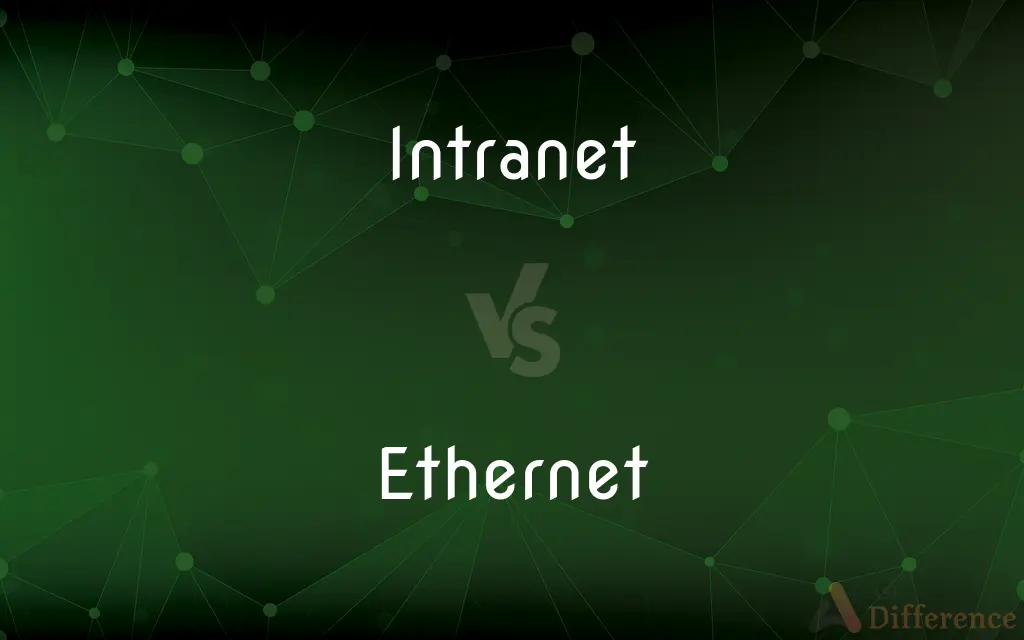Intranet vs. Ethernet — What's the Difference?
By Fiza Rafique & Urooj Arif — Updated on May 6, 2024
Intranet is a private network within an organization, using internet protocols for internal communications, while Ethernet is a technology for connecting devices in a local area network (LAN).

Difference Between Intranet and Ethernet
Table of Contents
ADVERTISEMENT
Key Differences
An intranet is designed to connect employees within an organization, providing a secure platform for sharing information and collaboration tools. In contrast, Ethernet is a physical and data link layer technology for networking that allows devices like computers and printers to communicate within a localized setting.
Intranets utilize web-based technologies to facilitate internal communications and access to corporate systems, whereas Ethernet provides the necessary infrastructure for data transmission between devices through cables and switches.
While intranets can be accessed through any device that is connected to the organization's network, Ethernet requires physical connections or wireless protocols to connect devices within a limited geographic area.
An intranet might be deployed over several different kinds of network technologies, including Ethernet, whereas Ethernet itself does not specify any applications or content, focusing purely on transmission and networking capabilities.
Intranets often feature security measures like firewalls and encryption to protect sensitive information, while Ethernet includes security protocols such as IEEE 802.1X for controlling network access.
ADVERTISEMENT
Comparison Chart
Definition
A private network within an organization.
Technology for connecting devices in a LAN.
Technology Type
Network based on internet protocols.
Network interface and physical layer.
Function
Internal communication and information share.
Physical data transmission.
Connectivity
Can be wireless or wired.
Primarily wired, but can be wireless (Wi-Fi).
Security
Often includes firewalls and encryption.
Uses protocols like IEEE 802.1X for security.
Compare with Definitions
Intranet
Facilitates centralized management of internal information.
The intranet serves as a repository for all internal policies.
Ethernet
A technology for linking computers in a local area network.
The office computers are interconnected via Ethernet.
Intranet
A tool for secure communication among employees.
Employees use the intranet to share real-time data about project progress.
Ethernet
Uses cables, switches, and routers for connectivity.
Ethernet cables run throughout our building to connect various devices.
Intranet
A platform for distributing company-specific applications.
Our intranet hosts all our training modules and compliance software.
Ethernet
Primarily concerned with data transmission rates.
Ethernet networks are often upgraded to improve speed and efficiency.
Intranet
A network that uses internet protocols confined within an organization.
The company’s intranet allows staff to access HR documents securely.
Ethernet
Operates at the data link layer of the OSI model.
Ethernet handles the framing of data packets for network communications.
Intranet
Typically requires login credentials for access.
Every employee has unique intranet login credentials.
Ethernet
Can facilitate both wired and wireless connections.
Modern Ethernet setups can incorporate wireless routers.
Intranet
An intranet is a computer network for sharing information, collaboration tools, operational systems, and other computing services within an organization, usually to the exclusion of access by outsiders. The term is used in contrast to public networks, such as the Internet, but uses most of the same technology based on the Internet Protocol Suite.A company-wide intranet can constitute an important focal point of internal communication and collaboration, and provide a single starting point to access internal and external resources.
Ethernet
Ethernet () is a family of wired computer networking technologies commonly used in local area networks (LAN), metropolitan area networks (MAN) and wide area networks (WAN). It was commercially introduced in 1980 and first standardized in 1983 as IEEE 802.3.
Intranet
A privately maintained computer network that can be accessed only by authorized persons, especially members or employees of the organization that owns it.
Ethernet
Alternative case form of Ethernet
Intranet
(computing) A private computer network, typically one that uses the protocols of the Internet.
Ethernet
A type of networking technology for local area networks; coaxial cable carries radio frequency signals between computers at a rate of 10 megabits per second
Intranet
A restricted computer network; a private network created using World Wide Web software
Common Curiosities
What is the main use of an intranet?
To facilitate internal communication and resource sharing within an organization.
Is Ethernet secure?
Yes, Ethernet includes features like network access control, but overall security depends on additional network settings.
What is the difference between the internet and an intranet?
The internet is a global network, whereas an intranet is restricted to an organization.
How does Ethernet work?
Ethernet connects devices through a series of cables and hardware like switches to enable communication within a network.
What speeds do Ethernet connections typically support?
Ethernet speeds can vary, commonly from 10 Mbps to 10 Gbps.
Can intranet work without Ethernet?
Yes, intranets can operate over various network technologies, not just Ethernet.
What are the components of an Ethernet network?
Components include cables, adapters, hubs, switches, and routers.
How does an intranet improve organizational efficiency?
By centralizing access to resources and communication tools, an intranet enhances operational efficiency.
Can an intranet be accessed remotely?
Yes, with appropriate security measures such as VPNs, intranets can be accessed remotely.
Are there wireless Ethernet technologies?
Yes, technologies like Wi-Fi fall under the category of wireless Ethernet options.
Share Your Discovery

Previous Comparison
Forbearing vs. Bearing
Next Comparison
Department vs. DepartmentalAuthor Spotlight
Written by
Fiza RafiqueFiza Rafique is a skilled content writer at AskDifference.com, where she meticulously refines and enhances written pieces. Drawing from her vast editorial expertise, Fiza ensures clarity, accuracy, and precision in every article. Passionate about language, she continually seeks to elevate the quality of content for readers worldwide.
Co-written by
Urooj ArifUrooj is a skilled content writer at Ask Difference, known for her exceptional ability to simplify complex topics into engaging and informative content. With a passion for research and a flair for clear, concise writing, she consistently delivers articles that resonate with our diverse audience.
















































